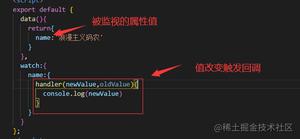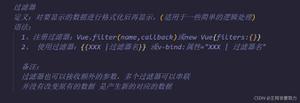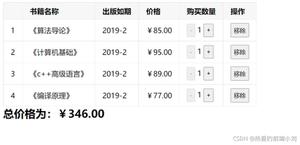Vue基础

Vue.js起手式+Vue小作品实战
本文是小羊根据Vue.js文档进行解读的第一篇文章,主要内容涵盖Vue.js的基础部分的知识的,文章顺序基本按照官方文档的顺序,每个知识点现附上代码,然后根据代码给予个人的一些理解,最后还放上在线编辑的代码以供练习和测试之用;
在最后,我参考SegmentFault上的一篇技博,对Vue进行初入的实战,目的是将新鲜学到的知识立即派上用场;
如果你还是前端的小白,相信这篇文章可能会对产生一些帮助和引起思想的碰撞,因为大家的学习历程是相似的,遇到的困惑也有一定的共通性,如果文章出现谬误之处,欢迎各位童鞋及时指正;
目录
1.Vue.js是什么
2.Vue.js的基本语法
3.Vue.js的小作品
1. Vue.js是什么
Vue.js(读音 /vjuː/, 类似于 view) 是一套构建用户界面的 渐进式框架。与其他重量级框架不同的是Vue 的核心库只关注视图层。
Vue.js 的目标是通过尽可能简单的 API 实现响应的数据绑定和组合的视图组件。
Vue.js是一种MVVM框架,其中html是view层,js是model层,通过vue.js(使用v-model这个指令)完成中间的底层逻辑,实现绑定的效果。改变其中的任何一层,另外一层都会改变;
2.Vue的基本语法
2.1 Vue构造函数开启Vue之旅
通过构造函数Vue创建一个Vue的根实例
1 <div id='#el'></div>2 ---
3 var vm = new Vue({
4 //options
5 el:'#el',
6 data:{},
7 methods:{}
8 })
9 ---
10 //扩展Vue构造器
11 var MyComponent = Vue.extend({
12 //扩展选项
13 })
14 var vm = new MyComponent({})
解读:
- 使用Vue构造函数创建一个Vue实例,然后通过Vue实例的el接口实现和HTML元素的挂载;
- 构造函数Vue需要传入一个选项对象,可包含挂载元素、数据、方法和生命周期钩子等;
- 构造函数Vue可以通过extend方法实现扩展,从而可以用预定义的选项创建可复用的组件构造函数,但是构建组件的常用方法是使用Vue.component()接口去实现;
2.2 Vue实例的属性和方法
Vue实例将代理data对象的所有属性,也就是说部署在data对象上的所有属性和方法都将直接成为Vue实例的属性和方法
1 <div id="app">{{message}} 2 <button v-on:click="sayHello">click me</button>
3 </div>
4 ---
5 var app = new Vue({
6 el:'#app',
7 data:{
8 message:'hello world!',
9 sayHello:function(){
10 console.log(1)
11 }
12 }
13 })
14 ---
15 //如果想要获取到app这一实例中选项的对象,Vue提供$进行获取
16 app.$el === document.getElementById('app')//true
17 app.$data.message//hello world
【demo】
【TIP】
Vue实例所代理data对象上的属性只有在实例创建的同时进行初始化才具有响应式更新,若在实例创建之后添加是不会触发视图更新的;
2.3数据绑定操作
绑定文本和HTML
1 <div id = "app">2 {{msg}}
3 <div v-html="hi"></div>
4 </div>
5 ---
6 var app = new Vue({
7 el: '#app',
8 data:{
9 msg: 'hello world!',
10 hi:'<h1>hi</h1>'
11 }
12 })
解读:
- HTML部分实现数据的动态绑定,这个数据是vue实例的属性值;
- JS部分的语法可以从jQuery角度去理解,相当于创建一个Vue实例,这个实例指向#app,并在Vue提供的固定接口data上定义Vue实例的属性;
- 使用{{message}}的mustache语法只能将数据解释为纯文本,为了输出HTML,可以使用v-html指令;
绑定数据在元素的属性
1 <div id="app" v-bind:title='message' v-bind:style='red' v-once>2 {{message}}
3 </div>
4 ---
5 var app = new Vue({
6 el: '#app',
7 data:{
8 message: 'hello world!',
9 red: 'color:red'
10 }
11 })
解读:
- 定义在Vue实例的data接口上的数据的绑定灵活的,可以绑定在DOM节点内部,也可以绑在属性上;
- 绑定数据到节点属性上时,需要使用v-bind指令,这个元素节点的 title属性和 Vue 实例的 message属性绑定到一起,从而建立数据与该属性值的绑定,也可以使用v-bind:href="url"的缩写方式:href="url";
- v-once指令能够让你执行一次性的插值,当数据改变时,插值处的内容不会更新;
【demo】
使用JS表达式处理数据
1 <div id='#app'>2 <p v-once>{{num + 10 }}</p>
3 <p v-if='seen'>{{message + 'jirengu'}}</p>
4 </div>
5 ---
6 var app = new Vue({
7 el: '#app',
8 data:{
9 num:10,
10 message: 'hello world!',
11 seen:true
12 }
13 })
【demo】
使用过滤器来格式化数据
<div id="app" ><p v-if='seen'>{{message | capitalize}}</p>
</div>
---
var app = new Vue({
el: '#app',
data:{
message: 'hello world!',
seen:true,
},
filters:{
capitalize:function(value){
if(!value) return ''
value = value.toString()
return value.charAt(0).toUpperCase() + value.slice(1)
}
}
})
【demo】
条件指令控制DOM元素的显示操作
1 <div id="app" >2 <p v-if='seen'>{{message}}</p>
3 </div>
4 ---
5 var app = new Vue({
6 el: '#app',
7 data:{
8 message: 'hello world!',
9 seen:true
10 }
11 })
解读:
- v-if指令可以绑定一个属性值为布尔型的属性,当值为真时,元素将显示,反之则消失;
循环指令实现数据的遍历
1 <div id="app">2 <ol>
3 <li v-for='item in items'>
4 {{ item.text }}
5 </li>
6 </ol>
7 </div>
8 ---
9 var app = new Vue({
10 el: '#app',
11 data:{
12 items:[
13 {text:'Vue'},
14 {text:'React'},
15 {text:'Angular'}
16 ]
17 }
18 })
解读:
- v-for可以绑定数组型数据进行绑定,并使用item in items形式,从而数据的遍历操作;
【demo】
事件绑定指令可以实现事件监听
1 <div id='app'>2 <p>{{message}}</p>
3 <button v-on:click='reverseMessage'>reverseMesssage</button>
4 </div>
5 ---
6 var app = new Vue({
7 el: '#app',
8 data:{
9 message: 'hello world!'
10 },
11 methods:{
12 reverseMessage:function(){
13 this.message = this.message.split('').reverse().join('')
14 }
15 }
16 })
解读:
- v-on指令用于监听事件操作,click="reverseMessage"定义点击事件后执行的回调函数;
- v-on指令也可以采用缩写方式:@click="method"
- 在Vue实例中,提供methods接口用于统一定义函数;
【demo】
小结
本章涉及Vue的基础的数据绑定操作,内容包括:
- {{message}}实现文本数据的绑定,并且文本数据可以使用JS表达式和过滤器进行进一步处理;
-v-html="hi"实现HTML数据的绑定; - v-bind:href="url"实现属性数据的绑定;
- v-if="seen"和v-for="item in items"指令实现流程控制;
- v-on:click="method"指令实现事件监听
2.4计算属性
使用计算属性完成一些数据计算操作
1 <div id="app" >2 <p>Original message : {{message}}</p>
3 <p>Reversed message : {{ReversedMessage}}</p>
4 </div>
5 ---
6 var app = new Vue({
7 el: '#app',
8 data:{
9 message: 'hello world!',
10 },
11 computed:{
12 ReversedMessage:function(){
13 return this.message.split('').reverse().join('')
14 }
15 }
16 })
解读:
- Vue实例提供computed对象,我们可以在对象内部定义需要进行计算的属性ReverseMessage,而提供的函数将作为属性的getter,即获取器;
- 上述的代码使得app.ReverseMessage依赖于app.message;
- 与先前直接在{{message.split('').reverse().join('') }}使用表达式相比,它让模板过重并且难以维护代码;
计算属性 VS Methods
1 <div id="app" >2 <p>Original message : {{message}}</p>
3 <p>Reversed message : {{ReversedMessage}}</p>
4 <p>Reversed message:{{reversedMessage()}}</p>
5 </div>
6 ---
7 var app = new Vue({
8 el: '#app',
9 data:{
10 message: 'hello world!',
11 },
12 computed:{
13 ReversedMessage:function(){
14 return this.message.split('').reverse().join('')
15 }
16 },
17 methods:{
18 reversedMessage:function(){
19 return this.message.split('').reverse().join('')
20 }
21 }
22 })
23 解读:
24
25 通过Vue实例的methods接口,我们在模板中调用reversedMessage函数同样实现需求;
26 methods与computed方法的区别在于:computed的数据依赖于app.message,只要message未变,则访问ReverseMessage计算属性将立即返回之前的计算结果,而methods则每次重新渲染时总是执行函数;
27 如果有缓存需要,请使用computed方法,否则使用methods替代;
28 计算属性的setter
29
30 Vue实例的computed对象默认只有getter,如果你要设置数据,可以提供一个setter,即设置器;
31
32 <div id="app" >
33 <p>Hi,I'm{{fullName}}</p>
34 </div>
35 ---
36 var app = new Vue({
37 el: '#app',
38 data:{
39 message: 'hello world!',
40 name:'Teren'
41 },
42 computed:{
43 fullName:{
44 get:function(){
45 return this.name
46 },
47 set:function(value){
48 this.name = value
49 }
50 }
51 }
52 })
2.5Class与Style的绑定
绑定Class
1 <div id="app" >2 <!-- 直接绑定对象的内容 -->
3 <p class='static' v-bind:class="{active:isActive,error:hasError}">Hello world!</p>
4 <!-- 绑定对象 -->
5 <p v-bind:class="classObj">こんにちは </p>
6 <p v-bind:class='style' >你好</p>
7 <!-- 绑定数组 -->
8 <p v-bind:class="[staticClass,activeClass,errorClass]">
9 Olá</p>
10 <button @click='changeColor'>click me</button>
11 </div>
12 ---
13 //css
14 .static{
15 width: 200px;
16 height: 100px;
17 background: #ccc;
18 }
19 .active{
20 color:red;
21 }
22 .error{
23 font-weight: 800;
24 }
25 ---
26 var app = new Vue({
27 el: '#app',
28 data:{
29 isActive:true,
30 hasError:true,
31 classObj:{
32 static:true,
33 active:true,
34 error:true,
35 },
36 staticClass:'static',
37 activeClass:'active',
38 errorClass:'error',
39
40 },
41 computed:{
42 style:function(){
43 return {
44 active: this.isActive,
45 static:true,
46 error:this.hasError
47 }
48 }
49 },
50 methods:{
51 changeColor:function(){
52 this.isActive = !this.isActive
53 }
54 }
55 })
解读:
- 通过v-bind:class="{}"或v-bind:class=[]方式为模板绑定class
- 通过v-bind:class="{active:isActive,error:hasError}"绑定class,首先要在css中设置.active和,error,然后在Vue实例的data对象中设置isActive和hasError的布尔值;也可以直接传一个对象给class,即v-bind:class="classObj,再在data对象上直接赋值:
?
1 2 3 4 5 6 7 8 9 10 11 12 |
|
【TIP】无论是哪种方式,前提都是css中的class要先设定
【demo】
绑定style
1 <div id="app" >2 <p v-bind:style='styleObj'>Hello World!</p>
3 <p v-bind:style='[styleObj,bgObj]'>你好</p>
4 </div>
5 ---
6 var app = new Vue({
7 el: '#app',
8 data:{
9 styleObj:{
10 fontWeight:800,
11 color:'red'
12 },
13 bgObj:{
14 width:'100px',
15 height:'80px',
16 background:'#ccc'
17 }
18 },
19 })
解读:
- 绑定style到模板的方法有两种,一是v-bind:style="styleObj",然后在data对象上定义styleObj;而是可以通过数组方式为style传入多个样式对象
【demo】
2.6条件渲染和列表渲染
前面简单介绍了一下v-if、v-for和v-on指令,下面的部分将详细介绍以上3个指令;
条件渲染
1 <div id="app" >2 <p v-if='ok'>Hello World!</p>
3 <p v-else>Hello Universal</p>
4 <template v-if='motto'>
5 <h1>Steve Jobs</h1>
6 <p>motto:stay hungry ! stay foolish</p>
7 </template>
8 <p v-show='ok'>Show Me</p>
9 </div>
10 ---
11 var app = new Vue({
12 el: '#app',
13 data:{
14 ok:true,
15 motto:true,
16 },
17 })
解读:
- 通过v-if和v-else指令实现条件渲染,其中v-if="value"的valuey
要在data对象中赋布尔值,v-if支持<template>语法 - v-show="value"是另一种条件渲染的方法;
【TIP】 v-if和v-show的区别
- v-if是真实的条件渲染,当进行条件切换时,它会销毁和重建条件块的内容,并且它支持<template>语法;
- v-show的条件切换时基于css的display属性,所以不会销毁和重建条件块的内容;
- 当你频繁需要切换条件时,推荐使用v-show;否则使用v-if;
【demo】
列表渲染
1 <div id="app" >2 <ol>
3 <li v-for='car in cars'>
4 {{car.name}}
5 </li>
6 </ol>
7 <ul>
8 <li v-for='(food,index) in foods'>
9 {{index}}---{{food}}---{{delicious}}
10 </li>
11 </ul>
12 <ul>
13 <li v-for='(value,key,index) in object'>
14 {{index}}.{{key}}.{{value}}
15 </li>
16 </ul>
17 <div>
18 <span v-for='n in 10' style="margin-left:5px">{{n}}</span>
19 </div>
20 <span v-for='n in evenNumbers' style="margin-left:5px">{{n}}</span>
21 </div>
22 <!-- <div>
23 <span v-for='n in odd(counts)' style="margin-left:5px">{{n}}</span>
24 </div> -->
25 </div>
26 ---
27 var app = new Vue({
28 el: '#app',
29 data:{
30 delicious:'delicious',
31 cars:[
32 {name:'Benz'},
33 {name:'BMW'}
34 ],
35 foods:[
36 'tomato',
37 'potato',
38 'ice cream'
39 ],
40 object :{
41 name:'Benz',
42 age:'18'
43 },
44 numbers:[1,2,3,4,5,6,7,8,9,10],
45 counts:[1,2,3,4,5]
46 },
47 computed:{
48 evenNumbers:function(){
49 return this.numbers.filter(function(number){
50 return number%2 === 0
51 })
52 }
53 },
54 methods:{
55 odd:function(counts){
56 return counts.filter(function(count){
57 return count%2 === 1;
58 })
59 }
60 }
61 })
62 解读:
63
64 v-for指令能够让我们循环渲染列表型数据,数据放在data对象中,类型可以如下:
65 data:{
66 //数字数组
67 numbers:[1,2,3,4,5,6,7,8,9,10],
68 counts:[1,2,3,4,5]
69 //字符串数组
70 foods:[
71 'tomato',
72 'potato',
73 'ice cream'
74 ],
75 //对象数组
76 cars:[
77 {name:'Benz'},
78 {name:'BMW'}
79 ],
80 //对象
81 object :{
82 name:'Benz',
83 age:'18'
84 },
85 }
86 根据不同类型的数据,v-for指令在模板中具体采用的语法如下:
87 //数据为数字数组
88 <div>
89 <span v-for="n in numbers">{{n}}</span>
90 </div>
91 ---
92 //数据为字符数组
93 <ul>
94 <ol v-for='food in foods'>{{food}}</ol>
95 </ul>
96 ---
97 //数据为对象
98 <ul>
99 <ol v-for="value in object">{{value}}</ol>
100 </ul>
101 //或者
102 <ul>
103 <ol v-for="(value,key,index) in object">{{index}}.{{key}}.{{value}}</ol>
104 </ul>
105 ---
106 //数据为对象数组
107 <ul>
108 <ol v-for="car in cars">{{car.name}}</ol>
109 </ul>
110 在 v-for块中,我们拥有对父作用域属性的完全访问权限;
111 【demo】
112
113 2.7 事件监听
114
115 简单的事件监听——直接在指令上处理数据
116
117 <div id="#app">
118 <p v-on:click="counter+=1">{{counter}}</p>
119 </div>
120 ---
121 var app = new Vue({
122 el: "#app",
123 data:{
124 counter: 0,
125 }
126 })
127 复杂的事件监听——在methods对象定义回调函数
128
129 <div id="#app">
130 <p v-on:click="greet">{{vue}</p>
131 </div>
132 ---
133 var app = new Vue({
134 el: "#app",
135 data:{
136 vue:"hello Vue.js"
137 },
138 methods:{
139 greet:function(event){
140 console.log(this.vue)
141 }
142 }
143 })
事件修饰符——调用事件对象函数的快捷方式
1 <div v-on:click.prevent="greet">1</div>//等价于event.preventDefault()2 <div v-on:click.stop="greet">2</div>//等价于event.stopPropagation()
3 <div v-on:click.capture="greet">3</div>//等价于事件回调函数采用捕获阶段监听事件
4 <div v-on:click.self="greet">4</div>//等价于event.target
按键修饰符——按键事件的快捷方式
常见按键别名包括:- enter
- tab
- delete
- esc
- space
- up
- down
- left
- right
【demo】
2.8 表单控件绑定
文本控件
1 <div id="app">2 <p>{{message}}</p>
3 <input type="text" v-model='message'>
4 </div>
5 ---
6 var app = new Vue({
7 el:'#app',
8 data:{
9 message:'Hello World!'
10 },
11 })
解读:
- 通过v-model指令可以实现数据的双向绑定,即View层的数据变化可以直接改变Model层的数据,而Model层的数据改变也可以直接反映在View层;
- 上述代码v-model="message"使得input的value属性和message属性绑定,在输入框输入值,即改变value同时也改变message;
单选控件
1 <input id="man" value="man" type="radio" v-model='picked'>2 <label for="man">Man</label>
3 <br>
4 <input id="woman" value="woman" type="radio" v-model='picked'>
5 <label for="woman">Woman</label>
6 <div style="margin-left:10px">{{picked}}</div>
7 ---
8 var app = new Vue({
9 el:'#app',
10 data:{
11 message:'Hello World!',
12 picked:'man'
13 },
14 })
解读:
- v-model指令绑定data对象的picked属性,该属性默认指向type='radio'的input的value;
复选框
1 <input type="checkbox" id="Benz" v-model='checked' value='Benz'>2 <label for="Benz">Benz</label>
3 <input type="checkbox" id="BMW" v-model='checked' value="BMW">
4 <label for="BMW">BMW</label>
5 <div>Checked Name:{{checked}}</div>
6 ---
7 var app = new Vue({
8 el:'#app',
9 data:{
10 message:'Hello World!',
11 picked:'man',
12 selected:"A",
13 checked:[],
14 },
15 })
【demo】
2.9 组件
组件可以扩展 HTML 元素,封装可重用的代码。在较高层面上,组件是自定义元素;
通过Vue.component()接口将大型应用拆分为各个组件,从而使代码更好具有维护性、复用性以及可读性注册组件
1 <div id="app">2 <my-component></my-component>
3 </div>
4 ---
5
6 Vue.component('my-component',{
7 template:'<div>my-first-component</div>'
8 })
9
10 var app = new Vue({
11 el:'#app',
12 data:{
13 }
14 })
解读:
- 注册行为必须在创建实例之前;
- component的template接口定义组件的html元素;
局部注册组件
1 <div id="app">2 <my-component>
3 <heading></heading>
4 </my-component>
5 </div>
6 ---
7 Vue.component('my-component',{
8 template:'<div>my-first-component</div>'
9 })
10
11 var Child = {
12 template: '<h3>Hello World</h3>'
13 }
14
15 var app = new Vue({
16 el:'#app',
17 components:{
18 'my-component':Child
19 }
20 })
解读:
- 可以定义一个子组件,在实例的components接口中将子组件挂载到父组件上,子组件只在父组件的作用域下有效;
特殊DOM模板将会限制组件的渲染
像这些包含固定样式的元素<ul>, <ol>, <table>, <select>,
自定义组件中使用这些受限制的元素时会导致渲染失败;
通的方案是使用特殊的 is属性:
1 <table>2 <tr is="my-component">
3 </table>
创建组件的data对象必须是函数
1 <counter></counter>2 <counter></counter>
3 <counter></counter>
4 ---
5 Vue.component('counter',{
6 template:'<button @click="count+=1">{{count}}</button>',
7 data:function(){
8 return {
9 count: 0
10 }
11 }
12 })
解读:
- 在组件当中定义的数据count必须以函数的形式返回;
使用Props实现父组件向子组件传递数据
1 <child some-text='hello'></child>2 <br>
3 <child v-bind:some-text='message'> </child>
4 ---
5 Vue.component('child',{
6 template:'<div>{{someText}}</div>',
7 props:['someText']
8 })
9 var app = new Vue({
10 el:'#app',
11 components:{
12 'my-component':Child
13 },
14 data:{
15 message:"你好"
16 }
17 })
解读:
组件实例的作用域是孤立的。这意味着不能并且不应该在子组件的模板内直接引用父组件的数据。可以使用 props 把数据传给子组件;
可以用 v-bind动态绑定 props 的值到父组件的数据中。每当父组件的数据变化时,该变化也会传导给子组件,注意这种绑定方式是单向绑定;
【demo】
父组件是使用 props 传递数据给子组件,但如果子组件要把数据传递回去则使用自定义事件!
1 <div id="app">2 <p>{{total}}</p>
3 <button-counter v-on:increment='incrementTotal'></button-counter>
4 <button-counter @increment='incrementTotal'></button-counter>
5 </div>
6 ---
7 Vue.component('button-counter',{
8 template:'<button v-on:click="increment">{{counter}}</button>',
9 data:function(){
10 return {
11 counter:0
12 }
13 },
14 methods:{
15 increment:function(){
16 this.counter +=1;
17 this.$emit('increment')
18 }
19 }
20 })
21
22 var app = new Vue({
23 el:'#app',
24 data:{
25 total:0
26 },
27 methods:{
28 incrementTotal:function(){
29 this.total += 1;
30 }
31 }
32 })
解读:
- 父组件可以通过监听子组件的自定义事件,从而改变父组件的数据;
- 子组件每点击一次,触发increment函数,该函数在执行过程中通过$emit('increment')发出increment事件;
- button控件同时监听increment事件,每次发出该事件就改变父组件的total值;
【demo】
使用Slots分发内容
内容分发指的是混合父组件的内容与子组件自己的模板;
1 <div id="app">2 <h1>I'm the parent title</h1>
3 <my-component>
4 <p>This is some original content</p>
5 <p>This is some more original content</p>
6 </my-component>
7 <hr>
8 </div>
9 ---
10 Vue.component('my-component',{
11 template:"<div><h2>I'm the child title</h2><slot>如果没有分发内容则显示我。</slot></div>"
12 })
13 var app = new Vue({
14 el:'#app',
15 data:{
16 }.
17 })
解读:
- 如果子组件模板一个<slot>都不包含,则父组件内容将会被丢弃;
- 当子组件模板只有一个没有属性的 slot 时,父组件整个内容片段将插入到 slot 所在的 DOM 位置,并替换掉 slot 标签本身;
- 只有在宿主元素为空,且没有要插入的内容时才显示备用内容;
1 //子组件app-layout模板2 <div class="container">
3 <header>
4 <slot name="header"></slot>
5 </header>
6 <main>
7 <slot></slot>
8 </main>
9 <footer>
10 <slot name="footer"></slot>
11 </footer>
12 </div>
13 //父组件模板
14 <app-layout>
15 <h1 slot="header">Here might be a page title</h1>
16
17 <p>A paragraph for the main content.</p>
18 <p>And another one.</p>
19
20 <p slot="footer">Here's some contact info</p>
21 </app-layout>
22 //渲染结果
23 <div class="container">
24 <header>
25 <h1>Here might be a page title</h1>
26 </header>
27 <main>
28 <p>A paragraph for the main content.</p>
29 <p>And another one.</p>
30 </main>
31 <footer>
32 <p>Here's some contact info</p>
33 </footer>
34 </div>
解读:
- 具名slot相当于给slot设置标识符,只要在父组件的元素上设置<div slot="name"></div>就可以把该元素插入子组件定义的模板;
【TIP】关于组件的命名规范
- 当注册组件(或者 props)时,可以使用 kebab-case ,camelCase ,或 TitleCase
1 // 在组件定义中2 components: {
3 // 使用 camelCase 形式注册
4 'kebab-cased-component': { /* ... */ },
5 'camelCasedComponent': { /* ... */ },
6 'TitleCasedComponent': { /* ... */ }
7 }
- 在 HTML 模版中,请使用 kebab-case 形式:
1 <kebab-cased-component></kebab-cased-component>2 <camel-cased-component></camel-cased-component>
3 <title-cased-component></title-cased-component>
- 为了记忆方便,建议统一使用kebab-case形式;
【demo】
2.10 vue-resource插件
使用vue-rescource实现前后端的通信
在vue实例中新增ready对象,当页面完成加载时发出请求
1 new Vue({ 2 el: '#app',
3 ready: function() {
4 this.$http.get('book.json', function(data) {
5 this.$set('books', data);
6 }).error(function(data, status, request) {
7 console.log('fail' + status + "," + request);
8 })
9 //post方法:this.$http.post(url,postdata,function callback)
10 },
11 data: {
12 ....
13 books:''
14 },
15 .....
【TIP】
这个$http请求和jquery的ajax还是有点区别,这里的post的data默认不是以form data的形式,而是request payload。解决起来也很简单:在vue实例中添加headers字段:
http: { headers: {'Content-Type': 'application/x-www-form-urlencoded'} }3. 实战之Vue小作品
【Hello Vue.js】
上面的Vue小作品是小羊仿照SegmentFault的一篇技博的练手之作,建议各位对照源码亲手练习一次,以便初步熟悉Vue的使用;
【注】版权归Teren所有,转载请联系作者。
参考资料:
- Vue.js Docs
- Vue.js 快速入门
好文要顶
关注我
收藏该文
_佑
关注 - 20
粉丝 - 7
+加关注
2
0
« 上一篇:[译] jQuery 3 有哪些新东西
</div> <div class="postDesc">posted @ <span id="post-date">2017-01-04 17:40</span> <a href="https://www.cnblogs.com/wuhaojie/">_佑</a> 阅读(<span id="post_view_count">31586</span>) 评论(<span id="post_comment_count">2</span>) <a href="https://i.cnblogs.com/EditPosts.aspx?postid=6249585" rel="nofollow">编辑</a> <a href="#" onclick="AddToWz(6249585);return false;">收藏</a></div>
</div>
<script type="text/javascript">var allowComments=true,cb_blogId=223311,cb_entryId=6249585,cb_blogApp=currentBlogApp,cb_blogUserGuid='89acd442-e84e-e311-8d02-90b11c0b17d6',cb_entryCreatedDate='2017/1/4 17:40:00';loadViewCount(cb_entryId);var cb_postType=1;</script>
评论列表
<div class="feedbackItem"> <div class="feedbackListSubtitle">
<div class="feedbackManage">
<span class="comment_actions"></span>
</div>
<a href="#3795500" class="layer">#1楼</a><a name="3795500" id="comment_anchor_3795500"></a> <span class="comment_date">2017-09-25 10:27</span> <a id="a_comment_author_3795500" href="http://home.cnblogs.com/u/1228726/" target="_blank">cdx71666344</a> <a href="http://msg.cnblogs.com/send/cdx71666344" title="发送站内短消息" class="sendMsg2This"> </a>
</div>
<div class="feedbackCon">
<div id="comment_body_3795500" class="blog_comment_body">很赞的文章<br><a href="http://t.cn/RKSsoCW" target="_blank">http://t.cn/RKSsoCW</a></div><div class="comment_vote"><a href="javascript:void(0);" class="comment_digg" onclick="return voteComment(3795500,'Digg',this)">支持(0)</a><a href="javascript:void(0);" class="comment_bury" onclick="return voteComment(3795500,'Bury',this)">反对(0)</a></div>
</div>
</div>
<div class="feedbackItem">
<div class="feedbackListSubtitle">
<div class="feedbackManage">
<span class="comment_actions"></span>
</div>
<a href="#3834361" class="layer">#2楼</a><a name="3834361" id="comment_anchor_3834361"></a><span id="comment-maxId" style="display:none;">3834361</span><span id="comment-maxDate" style="display:none;">2017/11/8 8:50:21</span> <span class="comment_date">2017-11-08 08:50</span> <a id="a_comment_author_3834361" href="https://www.cnblogs.com/MrFive/" target="_blank">伴随风飞</a> <a href="http://msg.cnblogs.com/send/%E4%BC%B4%E9%9A%8F%E9%A3%8E%E9%A3%9E" title="发送站内短消息" class="sendMsg2This"> </a>
</div>
<div class="feedbackCon">
<div id="comment_body_3834361" class="blog_comment_body">感谢分享</div><div class="comment_vote"><a href="javascript:void(0);" class="comment_digg" onclick="return voteComment(3834361,'Digg',this)">支持(0)</a><a href="javascript:void(0);" class="comment_bury" onclick="return voteComment(3834361,'Bury',this)">反对(0)</a></div><span id="comment_3834361_avatar" style="display:none;">http://pic.cnblogs.com/face/805665/20150928174304.png</span>
</div>
</div>
<div id="comments_pager_bottom"></div></div><script type="text/javascript">var commentManager = new blogCommentManager();commentManager.renderComments(0);</script>
刷新评论刷新页面返回顶部
注册用户登录后才能发表评论,请 登录 或 注册,访问网站首页。
【推荐】超50万VC++源码: 大型组态工控、电力仿真CAD与GIS源码库!
【推荐】华为云11.11普惠季 血拼风暴 一促即发
【拼团】腾讯云服务器拼团活动又双叒叕来了!
【工具】SpreadJS纯前端表格控件,可嵌入应用开发的在线Excel
【推荐】腾讯云新注册用户域名抢购1元起
系统推荐博文:
· 坚持写博一年半,我的收获与成长
· VueJs2.0建议学习路线
· 20170116 码农日报
· vue入门
· Vue - 起手式
</div><!--end: forFlow --></div>
以上是 Vue基础 的全部内容, 来源链接: utcz.com/z/378016.html









